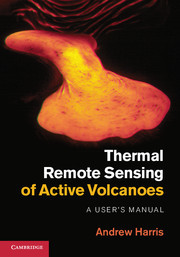Description
Thermal Remote Sensing of Active Volcanoes
A User's Manual
Author: Harris Andrew
A comprehensive manual exploring radiometry methodologies and principles used with satellite-, radiometer- and thermal-camera data, for academic researchers and graduate students.
Language: English
Subjects for Thermal Remote Sensing of Active Volcanoes:
Approximative price 144.47 €
In Print (Delivery period: 14 days).
Add to cart
Publication date: 04-2013
736 p. · 18.2x25.3 cm · Hardback
736 p. · 18.2x25.3 cm · Hardback
Description
/li>Contents
/li>Biography
/li>
Encapsulating over one hundred years of research developments, this book is a comprehensive manual for measurements of Earth surface temperatures and heat fluxes, enabling better detection and measurement of volcanic activity. With a particular focus on volcanic hot spots, the book explores methodologies and principles used with satellite-, radiometer- and thermal-camera data. It presents traditional applications using satellite and ground based sensors as well as modern applications that have evolved for use with hand-held thermal cameras and is fully illustrated with case studies, databases and worked examples. Chapter topics include techniques for thermal mixture modelling and heat flux derivation, and methods for data collection, mapping and time-series generation. Appendices and online supplements present additional specific notes on areas of sensor application and data processing, supported by an extensive reference list. This book is an invaluable resource for academic researchers and graduate students in thermal remote sensing, volcanology, geophysics and planetary studies.
Preface: background, motivation and essential definitions; Acknowledgements; 1. History of thermal remote sensing of active volcanism; 2. Thermal remote sensing of active volcanism: principles; 3. Satellite orbits and sensor resolution; 4. The mixed pixel, the dual-band technique, heat loss and volume flux; 5. Hot spot detection; 6. Mapping, classification, time series and profiles; 7. Broad-band radiometers: instrumentation and application; 8. Broad-band radiometers: data collection and analysis principles; 9. Broad–band thermal imaging cameras; Appendix A. Collation and summary of satellite-volcano radiometry: a literature database; Appendix B. Estimation of solar zenith angle and contribution of reflected radiation to at-satellite radiance; Appendix C. TM-Class sensors; Appendix D. AVHRR-Class sensors; Appendix E. GOES-Class sensors; Appendix F. Scan and satellite location geometry; Appendix G. Hot spot detection example; Appendix H. Optical pyrometers; References; Index.
Andrew Harris is a professor at Université Blaise Pascal (Clermont Ferrand, France) and holder of the Chaire d'Excellence for the Auvergne region. He is a member of the Remote Sensing Society, IAVCEI and AGU and has worked with a variety of ground- and satellite-based thermal data sets, having deployed experiments at active volcanoes in Africa, Europe, Central America, South America and Hawaii. Dr Harris has published over 130 publications in international scientific journals dedicated to thermal remote sensing and volcanology. His work has been recognised by several awards, including IAVCEI's Wager medal (2004) and the University of Hawai'i Regents' Medals for both excellence in research (2003) and teaching (2005).
© 2024 LAVOISIER S.A.S.




